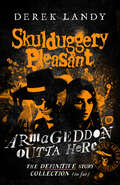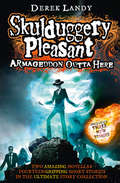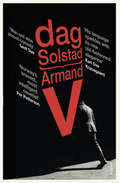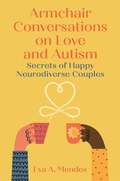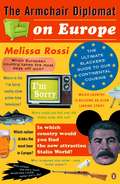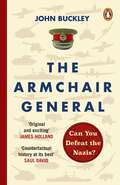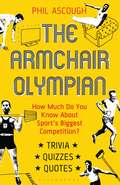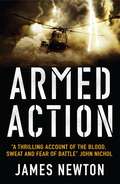- Table View
- List View
Armageddon in Waco: Critical Perspectives on the Branch Davidian Conflict
by Stuart A. WrightOn February 28, 1993, the United States Bureau of Alcohol, Tobacco, and Firearms (BATF) launched the largest assault in its history against a small religious community in central Texas. One hundred agents armed with automatic and semi automatic weapons invaded the compound, purportedly to execute a single search and arrest warrant. The raid went badly; four agents were killed, and by the end of the day the settlement was surrounded by armored tanks and combat helicopters. After a fifty-one day standoff, the United States Justice Department approved a plan to use CS gas against those barricaded inside. Whether by accident or plan, tanks carrying the CS gas caused the compound to explode in fire, killing all seventy-four men, women, and children inside. Could the tragedy have been prevented? Was it necesary for the BATF agents to do what they did? What could have been done differently? Armageddon in Waco offers the most detailed, wide-ranging analysis of events surrounding Waco. Leading scholars in sociology, history, law, and religion explore all facets of the confrontation in an attempt to understand one of the most confusing government actions in American history. The book begins with the history of the Branch Davidians and the story of its leader, David Koresh. Chapters show how the Davidians came to trouble authorities, why the group was labeled a "cult," and how authorities used unsubstantiated allegations of child abuse to strengthen their case against the sect. The media's role is examined next in essays that considering the effect on coverage of lack of time and resources, the orchestration of public relations by government officials, the restricted access to the site or to countervailing evidence, and the ideologies of the journalists themselves. Several contributors then explore the relation of violence to religion, comparing Waco to Jonestown. Finally, the role played by "experts" and "consultants" in defining such conflicts is explored by two contributors who had active roles as scholarly experts during and after the siege The legal and consitutional implications of the government's actions are also analyzed in balanced, clearly written detail.
Armageddon in Waco: Critical Perspectives on the Branch Davidian Conflict
by Stuart A. WrightOn February 28, 1993, the United States Bureau of Alcohol, Tobacco, and Firearms (BATF) launched the largest assault in its history against a small religious community in central Texas. One hundred agents armed with automatic and semi automatic weapons invaded the compound, purportedly to execute a single search and arrest warrant. The raid went badly; four agents were killed, and by the end of the day the settlement was surrounded by armored tanks and combat helicopters. After a fifty-one day standoff, the United States Justice Department approved a plan to use CS gas against those barricaded inside. Whether by accident or plan, tanks carrying the CS gas caused the compound to explode in fire, killing all seventy-four men, women, and children inside. Could the tragedy have been prevented? Was it necesary for the BATF agents to do what they did? What could have been done differently? Armageddon in Waco offers the most detailed, wide-ranging analysis of events surrounding Waco. Leading scholars in sociology, history, law, and religion explore all facets of the confrontation in an attempt to understand one of the most confusing government actions in American history. The book begins with the history of the Branch Davidians and the story of its leader, David Koresh. Chapters show how the Davidians came to trouble authorities, why the group was labeled a "cult," and how authorities used unsubstantiated allegations of child abuse to strengthen their case against the sect. The media's role is examined next in essays that considering the effect on coverage of lack of time and resources, the orchestration of public relations by government officials, the restricted access to the site or to countervailing evidence, and the ideologies of the journalists themselves. Several contributors then explore the relation of violence to religion, comparing Waco to Jonestown. Finally, the role played by "experts" and "consultants" in defining such conflicts is explored by two contributors who had active roles as scholarly experts during and after the siege The legal and consitutional implications of the government's actions are also analyzed in balanced, clearly written detail.
Armageddon in Waco: Critical Perspectives on the Branch Davidian Conflict
by Stuart A. WrightOn February 28, 1993, the United States Bureau of Alcohol, Tobacco, and Firearms (BATF) launched the largest assault in its history against a small religious community in central Texas. One hundred agents armed with automatic and semi automatic weapons invaded the compound, purportedly to execute a single search and arrest warrant. The raid went badly; four agents were killed, and by the end of the day the settlement was surrounded by armored tanks and combat helicopters. After a fifty-one day standoff, the United States Justice Department approved a plan to use CS gas against those barricaded inside. Whether by accident or plan, tanks carrying the CS gas caused the compound to explode in fire, killing all seventy-four men, women, and children inside. Could the tragedy have been prevented? Was it necesary for the BATF agents to do what they did? What could have been done differently? Armageddon in Waco offers the most detailed, wide-ranging analysis of events surrounding Waco. Leading scholars in sociology, history, law, and religion explore all facets of the confrontation in an attempt to understand one of the most confusing government actions in American history. The book begins with the history of the Branch Davidians and the story of its leader, David Koresh. Chapters show how the Davidians came to trouble authorities, why the group was labeled a "cult," and how authorities used unsubstantiated allegations of child abuse to strengthen their case against the sect. The media's role is examined next in essays that considering the effect on coverage of lack of time and resources, the orchestration of public relations by government officials, the restricted access to the site or to countervailing evidence, and the ideologies of the journalists themselves. Several contributors then explore the relation of violence to religion, comparing Waco to Jonestown. Finally, the role played by "experts" and "consultants" in defining such conflicts is explored by two contributors who had active roles as scholarly experts during and after the siege The legal and consitutional implications of the government's actions are also analyzed in balanced, clearly written detail.
Armageddon Insurance: Civil Defense in the United States and Soviet Union, 1945–1991 (The New Cold War History)
by Edward M. GeistThe dangerous, decades-long arms race between the United States and the Soviet Union during the Cold War begged a fundamental question: how did these superpowers actually plan to survive a nuclear strike? In Armageddon Insurance, the first historical account of Soviet civil defense and a pioneering reappraisal of its American counterpart, Edward M. Geist compares how the two superpowers tried, and mostly failed, to reinforce their societies to withstand the ultimate catastrophe.Drawing on previously unexamined documents from archives in America, Russia, and Ukraine, Geist places these civil defense programs in their political and cultural contexts, demonstrating how each country's efforts reflected its cultural preoccupations and blind spots and revealing how American and Soviet civil defense related to profound issues of nuclear strategy and national values. This work challenges prevailing historical assumptions and unearths the ways Moscow and Washington developed nuclear weapons policies based not on rational strategic or technical considerations but in power struggles between different institutions pursuing their own narrow self-interests.
Armageddon or Evolution?: The Scientific Method and Escalating World Problems
by Bernard S PhillipsWe are currently experiencing a wide range of evolving problems that threaten us with extinction. However, Phillips argues that we have the capacity-with the aid of a broad approach to the scientific method that builds on Mills's concept of "the sociological imagination"-to confront these problems ever more effectively. This book develops and builds upon new methods for addressing such social problems as global warming, terrorism, growing inequalities, and others. Phillips reveals procedures for achieving conscious evolution by uncovering fundamental assumptions and their contradictions and by moving toward alternative assumptions that promise to resolve these contradictions.
Armageddon or Evolution?: The Scientific Method and Escalating World Problems
by Bernard S PhillipsWe are currently experiencing a wide range of evolving problems that threaten us with extinction. However, Phillips argues that we have the capacity-with the aid of a broad approach to the scientific method that builds on Mills's concept of "the sociological imagination"-to confront these problems ever more effectively. This book develops and builds upon new methods for addressing such social problems as global warming, terrorism, growing inequalities, and others. Phillips reveals procedures for achieving conscious evolution by uncovering fundamental assumptions and their contradictions and by moving toward alternative assumptions that promise to resolve these contradictions.
Armageddon Outta Here – The World of Skulduggery Pleasant (Skulduggery Pleasant)
by Derek LandyThe ULTIMATE story collection for Skulduggery Pleasant fans, now updated to include Apocalypse Kings AND six more new stories for this edition.
Armageddon Outta Here - The World of Skulduggery Pleasant: The World Of Skulduggery Pleasant
by Derek LandyThe ULTIMATE story collection for Skulduggery Pleasant fans. Featuring two AMAZING novellas and fourteen GRIPPING short stories - including three new stories written exclusively for this edition.
The Armageddon Rag
by George R.R. MartinMagic, music, drugs and rock'n'roll in an early novel from George R. R. Martin, author of A GAME OF THRONESOne-time underground journalist Sandy Blair has traveled far from his radical roots in the '60s - until the bizarre and brutal murder of a millionaire rock promoter draws him back. As Sandy sets out to investigate the crime, he finds himself on a magical mystery tour of the pent-up passions of his generation. For a new messiah has resurrected the once legendary rock band Nazgûl - but with an apocalyptic new beat that is a requiem of demonism, mind control, and death only Sandy may be able to change in time ...
Armageddon—2419 A.D.: Revised Edition Of Original Version (Classics To Go)
by Philip Francis NowlanPhilip Francis Nowlan (1888 – February 1, 1940) was an American science fiction author, best known as the creator of Buck Rogers. Nowlan’s novella “Armageddon—2419 A.D.” tells about America in the 25th century, conquered by Hans in 2109 AD and only now beginning to rebel. Sometime after World War I, nearly all the European powers joined forces against the United States. Although the US won the war, both sides were devastated by the conflict. Taking advantage of the chaos that followed, the 'Russian Soviets' (USSR) joined forces with the 'Mongolians' to take over Europe. The US collapsed economically and stagnated while the 'Mongolians' turned against the Russians and defeated them as part of their campaign of world conquest. American efforts to avoid war with the 'Mongols' failed and in 2109 AD, they attacked the US using fleets of airships armed with disintegrator rays. They attacked from the Atlantic and Pacific coasts and down from Canada. After conquering the US and Canada, these 'Airlords of Han' ruled North America as a province of the world empire from fifteen great cities they established across the continent. They ignored the Americans who were left to fend for themselves in the forests and mountains as their advanced technology prevented the need for slave labor.[1] From time to time, they raid American land "to keep the 'wild' Americans on the run within the shelter of their forests, and prevent their becoming a menace to the Han civilisation." (Excerpt from Wikipedia)
Armageddon's Children: Book One of the Genesis of Shannara (Genesis of Shannara #1)
by Terry Brooks***50 MILLION TERRY BROOKS COPIES SOLD AROUND THE WORLD***THE SHANNARA CHRONICLES IS NOW A MAJOR TV SERIES'Terry's place is at the head of the fantasy world' Philip PullmanFifty years from now, our world is unrecognisable. Pollution and warfare have poisoned the skies, the water and the soil. Pockets of society still exist, living in highly fortified strongholds, while those outside the walls roam the landscape - either predator or prey. But even these isolated compounds are not safe; armies of demons and once-men assault their defences, and inevitably, one by one, they succumb. Civilisation has fallen and anarchy is the only law. Logan Tom and Angel Perez are the last two Knights to stand against the forces of chaos. These two extraordinary people have the ability to resist the dark tide, and to them will fall twin tasks: to find and protect a very old and a very new magic. They are humanity's last hope. Although the odds are stacked against them, Logan and Angel have the power to halt the destruction of the Old World. It will be up to others to usher in the New . . .Praise for Terry Brooks:'A master of the craft . . . required reading' Brent Weeks'I can't even begin to count how many of Terry Brooks's books I've read (and re-read) over the years' Patrick Rothfuss, author of The Name of the Wind'I would not be writing epic fantasy today if not for Shannara' Peter V. Brett, author of The Painted Man'If you haven't read Terry Brooks, you haven't read fantasy' Christopher Paolini, author of EragonThe Genesis of Shannara trilogy:ARMAGEDDON'S CHILDRENTHE ELVES OF CINTRATHE GYPSY MORPH
Armagh Folk Tales (Folk Tales: United Kingdom Ser.)
by Frances QuinnCounty Armagh, the Orchard County, abounds in folk tales, myths and legends and a selection of the best, drawn from historical sources and newly recorded local reminiscence, have been brought to life here by local storyteller Frances Quinn. Armagh is the place where, legend has it, the warrior king Conor Mac Nessa once ruled and where Deirdre of the Sorrows met her lover Naoise. It is where St Mochua’s Well was said to curse, not cure and where evidence of St Patrick’s disagreement with a bull can still be seen. And it is where Mrs Lester lived to a ripe old age – many years after her burial. It is also said to be the home of a plethora of strange and magical creatures and stories abound of encounters with fairies, dragons, ghosts, witches and even a giant pig. From age-old legends and fantastical myths to amusing anecdotes and cautionary tales, this collection is a heady mix of bloodthirsty, funny, passionate and moving stories. It will take you into a remarkable world where you can let your imagination run wild.
Armament, Arms Control and Artificial Intelligence: The Janus-faced Nature Of Machine Learning In The Military Realm (Studies In Peace And Security Ser.)
by Thomas Reinhold Niklas SchörnigArmand V
by Dag Solstad‘Solstad doesn’t write to please other people. Do exactly what you want, that’s my idea…the drama exists in his voice’ Lydia DavisArmand is a diplomat rising through the ranks of the Norwegian foreign office, but he’s caught between his public duty to support foreign wars in the Middle East and his private disdain of Western intervention. He hides behind his knowing ironic statements about the war, which no one grasps and which change nothing in the real world. Armand’s son joins the Norwegian SAS to fight in the Middle East, despite being specifically warned against such a move by his father, which leads to catastrophic, heartbreaking consequences. Told exclusively in footnotes to an unwritten novel, this is Solstad's radically unconventional novel about how we experience the passing of time: how it fragments, drifts, quickens, and how single moments can define a life.Winner of the Brage Prize
Armchair Conversations on Love and Autism: Secrets of Happy Neurodiverse Couples
by Eva A. MendesFilled with first-hand accounts and the best kept secrets to help your relationship bloom, this book is a deep dive into loving autistic relationships and the unique strengths that drive them.Based on clinical experience and emerging research, ASC counselling expert Eva Mendes explores the complex and fulfilling relationships between neurodiverse couples. This book takes you on a journey into the relationships of 20 neurodiverse couples from all walks of life, offering insight into how they meet the challenges of daily life and the unique strengths being neurodiverse can bring to a being a partner or co-parent. The couples share down-to-earth and candid recollections of the ups and downs of their relationships, weighing in on topics from emotional connection and sex to managing co-parenting and finances.Exploring multiple intersections from race, gender and sexuality across autistic relationships, and ironing out the common myths surrounding them, Eva offers a specialist, clinical perspective on each dynamic and provides examples of best practice to have a healthy and happy relationship.
The Armchair Diplomat on Europe: The Ultimate Slackers' Guide to Our Continental Cousins
by Melissa RossiIt happens all the time: you're watching the Champion's League, pondering Robert Kilroy Silk's unnatural glow, reading the latest newspaper debate about EU bendy banana laws, and thinking: what's really going on in Europe? Does anyone actually know what they're talking about? And where are Riga and Vilnius anyway? You needn't worry any more. With this armchair guide you'll discover the strange and fascinating world that calls itself Europe - without ever having to leave your own home. There are insights into culture (how to join the Finns beating themselves with birch twigs in the sauna); the lowdown on the people that matter (porn stars turned politicians in Italy); fascinating facts and explanations of historical rifts (and you thought the relationship between Britain and France was bad). You'll find out how to talk like Berlusconi, unravel the workings of the EU and guide yourself from the Baltics to Belgium, Portugal to Poland. The Armchair Diplomat: Europe offers the basics of euro-education for very little pain. Perfect for slackers with a passion for travel.
The Armchair General: Can You Defeat the Nazis? (The Armchair General #1)
by John Buckley***AVAILABLE FOR PRE-ORDER NOW***A ground-breaking approach to history where YOU choose the fate of WWII - perfect for readers of Bletchley Park Brainteasers and The GCHQ Puzzle Book.____________________________________________________________________________TAKE THE HOTSEATAssume the role of real Generals, Leaders, Soldiers and Intelligence Officers in the Allied Forces during WWII, including Winston Churchill and President Eisenhower.EXAMINE THE INTELLIGENCEExplore eight key moments of the war with real contemporaneous intelligence: Britain's Darkest Hour, 1940; The War in North Africa; Stalin's War on the Eastern Front; The Pacific Battle of Midway; The Dresden Bomber Offensive; Casablanca; Arnhem and Operation Market Garden; The Bomb and Hiroshima.CONSIDER THE SCENARIO & MAKE YOUR DECISIONFrom battlefields to war cabinets, each tactical and strategic decision you make leads to a different outcome.Will you follow the path of the past - or shape a new history?________________________'An original and exciting approach . . . Buckley is one of our very finest historians. The Armchair General adds enormously to our understanding of the conflicts.' JAMES HOLLAND'A reminder that history is a never ending now, a relentless and endless present that comes without the luxury of hindsight.' AL MURRAY, comedian and writer
The Armchair General World War One: Can You Win The Great War? (The Armchair General #2)
by John Buckley Spencer Jones‘The Armchair General team has done it again. An absorbing read for Christmas.’Peter Caddick-Adams‘Brilliant and immersive.’Harry SidebottomThe second book in the Armchair General series, where YOU choose the fate of the First World War________________________________HISTORY IS WRITTEN BY THE VICTORS. WILL IT BE YOU?TAKE THE HOTSEATAssume the role of real historic decision-makers: general, leaders, soldiers and intelligence officers of the Allied Forces during World War I.EXAMINE THE INTELLIGENCEExplore eight key moments from the First World War, using real contemporaneous intelligence: including the July Crisis, the Battle of the Somme, and the Russian Revolution.CONSIDER THE SCENARIO & MAKE YOUR DECISIONFrom battlefields to the Royal Courts, each tactical and strategic decision you make leads to a different outcome.Will you follow the path of the past - or shape a new history...?________________________________PRAISE FOR THE ARMCHAIR GENERAL SERIES'An original and exciting approach...The Armchair General adds enormously to our understanding of the conflicts' JAMES HOLLAND'A reminder that history is a never ending now, a relentless and endless present that comes without the luxury of hindsight' AL MURRAY'Wonderfully original...putting readers at the heart of the decision-making process and allowing them, literally, to change the course of history. This is counterfactual history at its very best' SAUL DAVID
The Armchair Olympian: How Much Do You Know About Sport's Biggest Competition?
by Phil AscoughBilled as the greatest sporting show on earth, the Olympic Games have produced countless memorable stories of achievement and endurance since entering the "modern" era in 1896.The major sports take a back seat - some of them long gone from the schedule - as sports fans discover new heroes excelling in obscure events that intrigue.The Games deliver triumph and heartbreak, serial winners and one-medal wonders, shocks and controversies - and tragedy in the true sense of the word rather than the often diluted sporting interpretation.For just over two weeks every four years handball and hockey, sailing and shooting, judo and gymnastics become prime time news. And the word "repechage" is common currency.The Armchair Olympian uses trivia, teasers, illustrations and quotes to recapture the magic of the story so far.
The Armchair Olympian: How Much Do You Know About Sport's Biggest Competition?
by Phil AscoughBilled as the greatest sporting show on earth, the Olympic Games have produced countless memorable stories of achievement and endurance since entering the "modern" era in 1896.The major sports take a back seat - some of them long gone from the schedule - as sports fans discover new heroes excelling in obscure events that intrigue.The Games deliver triumph and heartbreak, serial winners and one-medal wonders, shocks and controversies - and tragedy in the true sense of the word rather than the often diluted sporting interpretation.For just over two weeks every four years handball and hockey, sailing and shooting, judo and gymnastics become prime time news. And the word "repechage" is common currency.The Armchair Olympian uses trivia, teasers, illustrations and quotes to recapture the magic of the story so far.
Armed Action
by James Newton, Dfc'I couldn't see the tank. I couldn't see it... Someone was screaming over the radio. "Scream all you want, I still can't see it," I said to my pilot. The next explosion was so close it lifted my chest armour off my body in the shock wave. The noise brought me back to my awful reality. I looked out of the sight to see the shattered cockpit glass. The next one would be it and we knew it.' Lieutenant Commander James Newton survived and was awarded the Distinguished Flying Cross for his bravery. In a career that has seen him on operations over Bosnia, Sierra Leone, Northern Ireland and most recently Iraq, Newton is no stranger to being shot at. He has flown all the aircraft the Navy has and even ones it doesn't. Thrilling, fast-paced and an adrenaline-fuelled adventure, Armed Action is a fascinating insight into life in the air.
Armed Actors: Organized Violence and State Failure in Latin America
by Kees Koonings and Dirk KruijtIn this volume, Latin Americanist scholars explore the recent evidence relating to the ways in which partial state failure in the continent is interacting with new types of organized violence, thereby undermining the process of democratic consolidation that has characterized Latin America over the past two decades. This 'new violence' stems - as this book's case studies from Colombia, Peru, Argentina, Venezuela, Brazil and other countries, including El Salvador, show - from a heterogeneous variety of social actors including drug mafias, peasant militias and urban gangs (collectively referred to as actores armadas), as well as state-related actors like the police, military intelligence agencies and paramilitary forces.These armed actors are reproducing organized social and political violence beyond the confines of democratic politics and civil society. The results, as the authors warn, include both 'governance voids' - domains where the legitimate state is effectively absent in the face of armed actors prevailing by force - and an erosion of the capacity and willingness of state officials themselves to abide by the rule of law. These tendencies, in turn, pave the way for a possible reinstallation of authoritarian regimes under the control of politicized armies or, at the very least, the spread of state violence in one form or another.Why these tendencies need to be taken so seriously is, the authors argue, because of the deeper social roots underlying them - notably the failure of neoliberal economic policies and weakened state structures to deliver the jobs, standards of living and social services every democratic citizenry has a right to expect. The Argentinian collapse and persistent Colombian and Venezuelan crises receive special attention in this regard.
Armed Actors: Organized Violence and State Failure in Latin America
by Kees Koonings Dirk KruijtIn this volume, Latin Americanist scholars explore the recent evidence relating to the ways in which partial state failure in the continent is interacting with new types of organized violence, thereby undermining the process of democratic consolidation that has characterized Latin America over the past two decades. This 'new violence' stems - as this book's case studies from Colombia, Peru, Argentina, Venezuela, Brazil and other countries, including El Salvador, show - from a heterogeneous variety of social actors including drug mafias, peasant militias and urban gangs (collectively referred to as actores armadas), as well as state-related actors like the police, military intelligence agencies and paramilitary forces.These armed actors are reproducing organized social and political violence beyond the confines of democratic politics and civil society. The results, as the authors warn, include both 'governance voids' - domains where the legitimate state is effectively absent in the face of armed actors prevailing by force - and an erosion of the capacity and willingness of state officials themselves to abide by the rule of law. These tendencies, in turn, pave the way for a possible reinstallation of authoritarian regimes under the control of politicized armies or, at the very least, the spread of state violence in one form or another.Why these tendencies need to be taken so seriously is, the authors argue, because of the deeper social roots underlying them - notably the failure of neoliberal economic policies and weakened state structures to deliver the jobs, standards of living and social services every democratic citizenry has a right to expect. The Argentinian collapse and persistent Colombian and Venezuelan crises receive special attention in this regard.
Armed and Considered Dangerous: A Survey of Felons and Their Firearms
by Peter H. RossiArmed and Considered Dangerous is a book about "bad guys" and their guns. But Wright and Rossi contend that for every suspected criminal who owns and abuses a firearm, a hundred or more average citizens own guns for sport, for recreation, for self-protection, and for other reasons generally regarded as appropriate or legitimate. Armed and Considered Dangerous is the most ambitious survey ever undertaken of criminal acquisition, possession, and use of guns.There are vast differences between the average gun owner and the average gun-abusing felon, but the analyses reported here do not suggest any obvious way to translate these differences into gun control policies. Most policy implications drawn from the book are negative in character: this will not work for this reason, that will not work for that reason, and so on. When experts are asked, "Okay, then what will work?" they usually fall back on the old warhorses of poverty, the drug problem, or the inadequate resources of the criminal justice system, and otherwise have little to say. This is not a failure of social science. It simply asks more of the data than the data were ever intended to provide.Several of Wright and Rossi's findings have become "coin of the realm" in the gun control debate, cited frequently by persons who have long since forgotten where the data came from or what their limitations are. Several other findings, including many that are important, have been largely ignored. Still other findings have been superseded by better and more recent data or rendered anachronistic by intervening events. With the inclusion of a new introduction detailing recent statistics and updated information this new edition of Armed and Considered Dangerous is a rich source of information for all interested in learning about weapon behavior and ownership in America.
Armed and Considered Dangerous: A Survey of Felons and Their Firearms (Social Institutions And Social Change Ser.)
by Peter H. RossiArmed and Considered Dangerous is a book about "bad guys" and their guns. But Wright and Rossi contend that for every suspected criminal who owns and abuses a firearm, a hundred or more average citizens own guns for sport, for recreation, for self-protection, and for other reasons generally regarded as appropriate or legitimate. Armed and Considered Dangerous is the most ambitious survey ever undertaken of criminal acquisition, possession, and use of guns.There are vast differences between the average gun owner and the average gun-abusing felon, but the analyses reported here do not suggest any obvious way to translate these differences into gun control policies. Most policy implications drawn from the book are negative in character: this will not work for this reason, that will not work for that reason, and so on. When experts are asked, "Okay, then what will work?" they usually fall back on the old warhorses of poverty, the drug problem, or the inadequate resources of the criminal justice system, and otherwise have little to say. This is not a failure of social science. It simply asks more of the data than the data were ever intended to provide.Several of Wright and Rossi's findings have become "coin of the realm" in the gun control debate, cited frequently by persons who have long since forgotten where the data came from or what their limitations are. Several other findings, including many that are important, have been largely ignored. Still other findings have been superseded by better and more recent data or rendered anachronistic by intervening events. With the inclusion of a new introduction detailing recent statistics and updated information this new edition of Armed and Considered Dangerous is a rich source of information for all interested in learning about weapon behavior and ownership in America.



